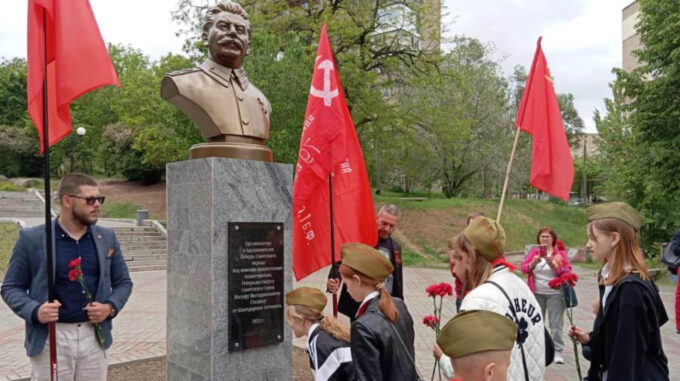Russian occupiers have once again staged a provocation in occupied Melitopol by installing a monument to Joseph Stalin on the occasion of Victory Day in World War II

This ostentatious act of vandalism and propaganda has become yet another confirmation that the temporary occupation authorities in southern Ukraine seek to rewrite history by glorifying the Soviet dictator as a symbol of “victory” and “heroism” of the Soviet people. According to sources, including the website of the Communist Party of Russia, this monument appeared in the city just before Victory Day — May 9. On its granite surface, a plaque is attached with the inscription: “To the organizer and inspirer of the Soviet people's victory over the German-fascist invaders, the Generalissimus of the Soviet Union, Joseph Vissarionovich Stalin, from grateful descendants.” This inscription leaves no doubt that even today, Russian propagandists are trying to rehabilitate Stalin’s image, which remains controversial in society due to his role in the tragic events of Ukraine’s and the world’s recent history. At the ceremony accompanying the monument’s unveiling, a representative of the Russian occupation forces — “deputy” Oleg Slyusarенко — spoke, emphasizing the importance of “restoring historical justice” and “remembrance” of the “great victory.” Local students also participated in the event — they laid flowers at the monument’s foot, demonstrating, perhaps, a government-controlled “interpretation” of history. It is also important to note that this monument was installed with the permission of the “city administration” of Melitopol, which is now under Russian military control. This further confirms that the occupation authorities attempt to create an illusion of “preserving traditions” and “respect for history,” while in reality, they are openly rewriting the past for propaganda purposes. It should be highlighted that the Soviet period of history, especially Stalin’s rule, remains one of the most controversial topics for Ukraine. His activities are particularly associated with the Holodomor — the large-scale famine-genocide of the Ukrainian people that claimed millions of lives in 1932–1933. According to Soviet ideology, those years were declared a “period of socialist construction,” but in modern Ukrainian historiography and society, this era is critically reassessed mainly because of mass repressions, humanitarian and economic catastrophes, and tragic events involving the Ukrainian people. The installation of a Stalin monument in Melitopol is not only an act of historical revisionism but also a clear signal of how Russian propaganda seeks to rewrite Ukrainian history by emphasizing symbols of the Soviet era. This causes deep concern among the public: for most Ukrainians, Stalin is associated with terror, the Holodomor, and repressions, not heroism. Currently, Ukrainian authorities, public figures, and historians are calling for a strict assessment of this act. They also emphasize that maintaining and spreading such monuments is not only an attempt to rehabilitate the dictator but also a means of continuing information warfare waged by Russia against Ukraine’s independence and national dignity. It is evident that this monument has also become another protest and reminder that Ukraine’s history and its struggle for freedom and self-determination must be clearly distinguished from Soviet myths and propaganda. Overall, the installation of the Stalin monument in Melitopol once again demonstrates the desperate efforts of Russian occupation forces to maintain control over history and the consciousness of residents in temporarily occupied territories, reminding everyone that the fight for the truth of history continues and is crucial for preserving Ukrainian identity.

